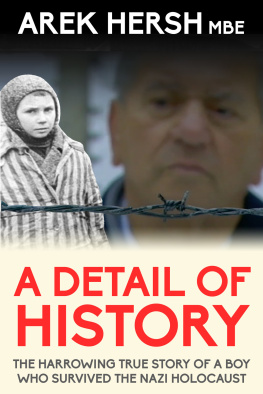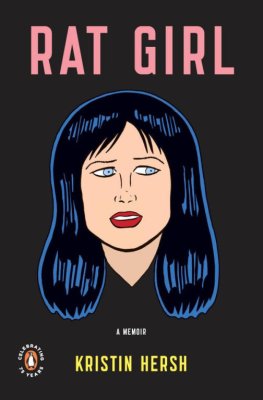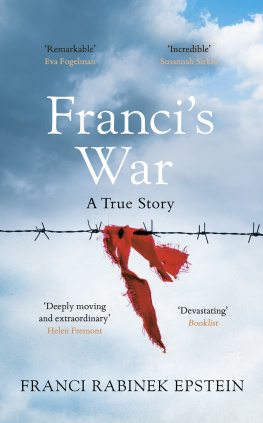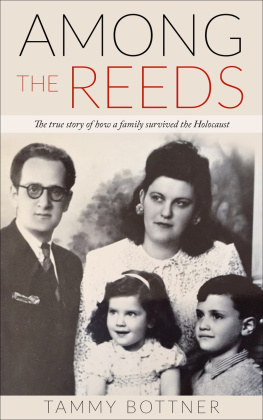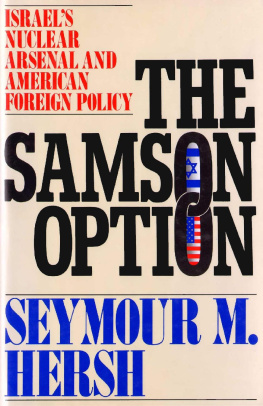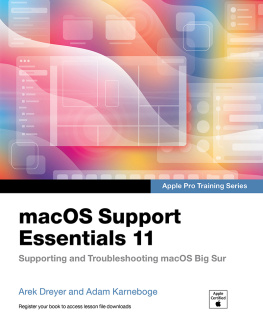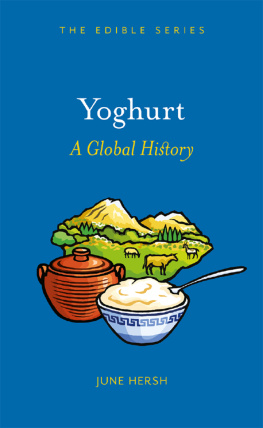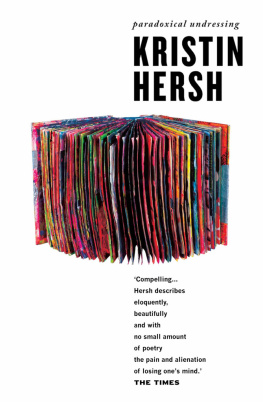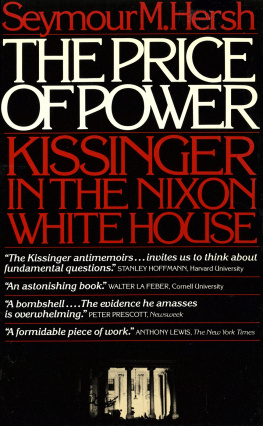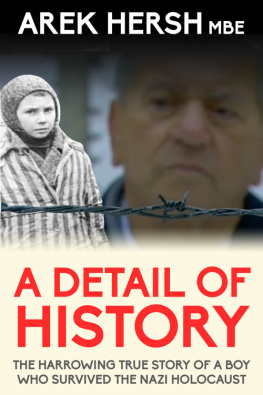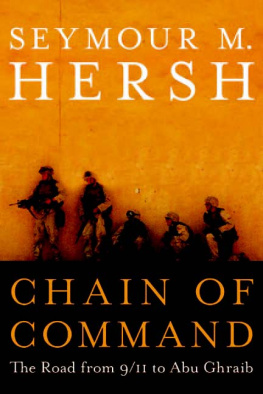About the author
Born in Sieradz in central Poland in 1928, Arek was the fourth of five children, with one brother and three sisters. His family were Orthodox Jews.
At the age of ten, he was sent by the Germans to Otoschno labour camp, where he was forced to work on the Warsaw-to-Berlin railway for the next two years. Of the 2,500 Jews in the labour camp, only 11 survived.
When Arek was 12, he was reunited with his family in Sieradz, but after just two weeks, he was transported to the Lodz ghetto. He never saw the rest of his family again. He found himself in an orphanage in Lodz and was given a job in the textile mill.
In June 1944 the Germans started to liquidate the ghetto and soon orders came through for the orphanage to be closed. All the children were to be resettled. On 25 August, about 185 of them assembled outside the orphanage. They were put onto a truck, taken to a small railway station and transported in cattle wagons to Birkenau-Auschwitz.
On arrival, when the selection took place, Arek realised that the Nazis were separating people into two rows, to the left and right. Although ordered to go to the left, he managed to cross to the right when the guards attention was distracted. Arek had just saved himself from certain death in the gas chambers. Of the 185 orphans, only Arek and two others survived the day.
In January 1945 Arek was among the thousands of men and women from Auschwitz forced onto a death march towards Germany. They marched for days until they eventually reached the large town of Katowice, where they were put into goods wagons. The journey in those wagons, destination unknown, lasted for several days without food.
They eventually arrived at their destination: Buchenwald concentration camp in Germany. Arek managed to survive in the most appalling conditions until, in April 1945, the Germans decided to evacuate the camp. The 4,500 inmates were on the march again towards the city of Weimar, where they were loaded onto open wagons.
After three and a half weeks on the train, mostly without food, they arrived in Czechoslovakia. On 4 May 1945, 600 of the original 4,500 men from Buchenwald arrived at Roundnice. The train was finally taken to the Theresienstadt ghetto, where, four days later, on 8 May, they were liberated by the Russian army. Arek had survived, but virtually all his family had been murdered. His only surviving relative was Mania, his eldest sister, whom he found in Ulm, Germany, in 1947.
After liberation, Arek was transported to England with 300 other children. They were given just 8 hours of English lessons and had to learn the rest for themselves.
Today, Arek lives in Leeds, England. He is married and has three daughters and seven grandchildren.
His years since the Holocaust have been quiet and happy. He has lived, worked and appreciated every moment of the life he now enjoys. For this reason, now that he has retired, he spends much of his time working with young people, sharing his story and reflecting with them on its meaning, past, present and future.
Contents
Publishing Information
PUBLISHED BY APOSTROPHE BOOKS LTD
ePub ISBN 978-1910-167-755
Mobi ISBN 978-1910-167-762
First published by Beth Shalom 1998
Republished by Quill Press 2001
This edition by Apostrophe Books 2015
(c) Arek Hersh 1998 & 2005
All photographs are the property of Arek Hersh and may not be reproduced without his written permission.
Arek has worked actively with the Sefton Holocaust Memorial Project, Liverpool, and on their behalf has taken several groups of young people to Poland. In 2004, along with the Sefton Holocaust Memorial Project and UNISON, he made a film simply entitled Arek . The film tells the story of his journey back to Poland where he relives the experiences at the sites where they took place. Where credited Unison, the photographs in the book are the property of Unison Film Productions, and have been reproduced with their kind permission.
The author has asserted his ownership of the electronic rights and his right under the Copyright, Designs and Patents Act 1988 to be identified as the author of this work.
A CIP catalogue record of this book is available from the British Library.
Apostrophe Books Ltd. Reg no. 7612239
Cover design and development by Jamie Downham
In memory
of my mother Bluma and father Szmuel ,
sisters Mania , Itka and brother Tovia,
and my little Dvora.
Deprived of life.
INTRODUCTION
It was the end of a long day. The sun was setting in the evening sky, its warmth making the red brick bell tower glow orange. It was undoubtedly a beautiful little church, its neatly trimmed lawns and pansy beds kept meticulously by the nuns from the adjoining convent. The old chestnut tree, broad and tall, had seen the faithful pass by to pray, day in and day out for many, many decades. And Christ hung from his cross above the doorway looking down onus as we peered through the locked gates. Christ and the chestnut tree had seen other things too.
Arek Hersh was only thirteen years old when he was brought to the little Polish Catholic church in Sieradz. Along with his mother, older sister and brother, aunties, uncles, cousins and members of the Jewish community, he was herded in amongst the pews to await his fate. Arek decided to leave the building to beg for water for his family. As he entered the courtyard, he was ordered to join a group selected to work elsewhere. From the moment he stepped out of the church, he never saw his family again. The next day they and all one thousand, four hundred Jews locked into the church were filed out of its doors, deported to Chelmno and murdered.
Areks story of survival combines the intensely tragic events of a family totally destroyed by the Nazis policy of mass murder and the intimate details of a community and of people needlessly wasted by these events. If the events he described were a mere detail of history to the Nazis, to the Jewish community and to all who care to stop and think, this remains one of the most challenging moments in the history of the world. Arek Hersh, in his understated and clearly written narrative, spells out just how tragic this was. From his description of life in his hometown Sieradz, to his long journey through the ghettos and camps, this little boy becomes a man who should never have grown up so quickly.
And yet as just a little boy, he makes decisions which save his life over and again. For those who look for survival in armed resistance, take a second look at this little boy and how at times, yes, fate was on his side; but also how often he instinctively manipulated the circumstance to his own advantage. In the end, as fate, chance and pure determination would have it, Arek survived. His family, his community and his civilisation did not.
Our little group huddled together outside the church in Sieradz, listening intently as Arek told his story, locked out of the gates that once locked him in. And the sun went down, the night was cold and the church was grey once more.
Dr. Stephen D. Smith
GLIMPSES OF CHILDHOOD
Memories of a normal world
Sieradz was an army garrison town with a population of eleven thousand six thousand Christians and five thousand Jews. The Jewish community was mainly composed of artisans and shopkeepers. It was set in rural surroundings, with forests on its horizons and fields of rapeseed shining like gold in the summer sun. It was a peaceful place, the River Warta passing its outskirts, and local history boasting that Queen Jadwiga of Poland had once had a castle here. On the corner of our street, Ulica Zamkowa - Castle Street - stood a building with underground passages which led to the castle.
Few strangers came to Sieradz except on market days, when peasants in national costume clattered through the cobbled streets in their clogs. They came regularly to sell livestock, butter, eggs and fruit. When columns of soldiers carrying guns passed by on their way to manoeuvres, my friends and I used to march behind the columns, carrying pieces of wood on our shoulders in place of guns. We used to watch, in admiration, the ceremony of swearing allegiance to Poland, held in the market square with lines of infantry and cavalry all lined up in uniform.
Next page
